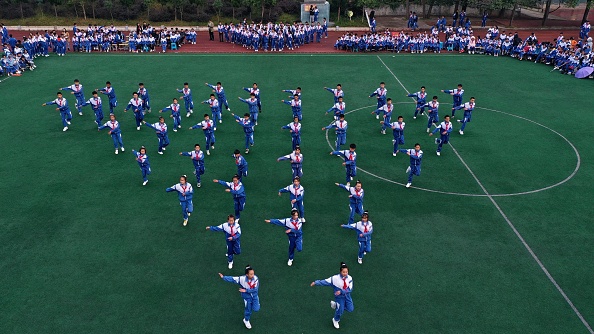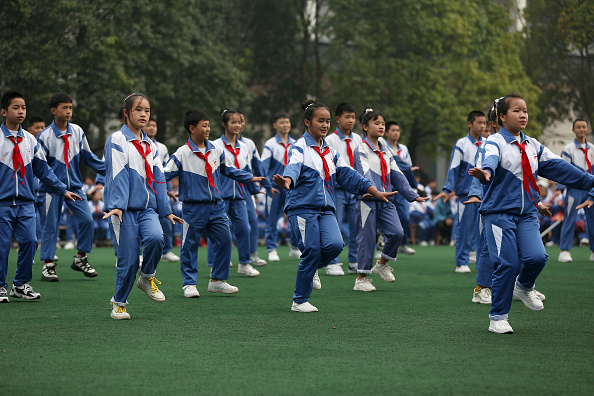
Miao students do a "Jinji exercise," Danzhai County, Guizhou Province, China, October 29, 2020. /Getty
Miao students do a "Jinji exercise," Danzhai County, Guizhou Province, China, October 29, 2020. /Getty
Editor's note: Wang Yan is an associate research fellow at the National Institute of Education Sciences. The article reflects the author's opinions, and not necessarily the views of CGTN.
Several days ago, state leaders and minsters from 100 countries gathered at the Global Education Meeting convened by United Nations Educational, Scientific and Cultural Organization (UNESCO) to re-imagine the role of education and recommit education as top priority in the world post COVID-19.
It was reiterated at the meeting that the world is off the track to realize the fourth sustainable development goal by 2030, "ensure inclusive and equitable quality education and promote lifelong learning opportunities for all."
Evidently, it is hard to plan for achievable objectives and goals in today's volatile, uncertain, complex and ambiguous world, especially with disruption caused by COVID-19 in various sectors and industries. Yet planning has been the cornerstone of socioeconomic development in China and has sustained China's growth since opening-up and reform four decades ago.
Taking the education sector as an example, it has been envisioned in the 13th Five-Year Plan (2016-2020, FYP) that gross enrollment rate for pre-primary education will reach 85 percent, gross enrollment rate of upper secondary education (senior high) will reach 90 percent, and compulsory education consolidation rate will reach 95 percent. Statistics released in early 2019 shows that China has already been very close to these targets. Other policy measures such as exemption of tuition and miscellaneous fees as well as recruiting and retaining high quality teachers in rural areas have also been implemented. If growth rate and momentum maintained, the goals will certainly be achieved by 2020 as planned five years ago.
Then what will be the priorities and targets for educational development over the next five years (2021-2025)? How will education be interlinked with economic and social development goals?
The new FYP aims for high-quality growth with new ethos and frameworks for a new phase of development, highlighting the central role of reform, opening-up and innovation toward modernization. Equitable and quality education will be the means of achieving quality growth as well as ends in terms of ensuring developmental opportunities and well-being of the Chinese people.
First, cultivation of ethics and morals has been noted as a fundamental task of educational development, underpinning the importance of beliefs, values and attitudes. In light of Chinese educational guidelines, cultivation of ethics and values will be applied as essential criteria for evaluation of school performance, as part of an education system that fosters ethical, cognitive, physical, aesthetic and practical competencies of younger generation as constructors and successors of the socialist cause.
Second, accelerated educational modernization will be the goal of the next five years plan, which supports the modernization of China as a whole. The government will continue the efforts for 10 priority actions mapped out in the Education 2035 with new ideology, new ethos and new strategies.
Third, quality will be the hallmark of educational development over the next five years, a shift away from access and toward quality learning opportunities for all as China has universalized basic education and moves to achieve mass higher education. Notably, modernized vocational education will play an increasingly larger role in boosting employment via re-skilling and up-skilling of the labor force.

"Jinji exercise," Danzhai County, Guizhou Province, China, October 29, 2020. /Getty
"Jinji exercise," Danzhai County, Guizhou Province, China, October 29, 2020. /Getty
Fourth, in line with supply-side structural reforms, structural educational reforms will also be undertaken, towards the goal of networked, digitalized education system that could provide customized services to meet the diversified needs of lifelong learning as well as demand of economic and social development.
Fifth, regional education policies will be updated to support the spearheading role of economic/developmental zones, such as Xiong'an New Area, Yangtze River Economic Zone and Hainan Free-Trade Zone. Universities will be incentivized to contribute to innovation in these zones and regions through academia-industry collaboration as well as coordinated development of industry chain, innovation chain and talent cultivation chain.
Last but not the least, the 14th FYP will see systemic reforms involving educational evaluation, entrance examination and admission schemes as well as the application of information technology and emerging technologies in teaching and learning.
It is hard to exhaust the list of goals and targets for five years for a vast country such as China. This first glimpse could give us a sense of strategies and approaches to be taken in the education sector for achieving quality growth.
People might ask why the plan is so significant and how far such plan can be exact taking into account uncertainties in today's world, particularly in the context of COVID-19.
Yet it is such planning that brought China into a relatively better-off society step by step over 40 years up to today. It is quite promising that China will take the lead in realizing the goal of UNESCO Education 2030 "provision of 12 years of free, publicly funded, equitable quality primary and secondary education, of which at least nine years are compulsory, leading to relevant learning outcomes," among other things which are hardly achievable for many developing countries yet.
Hence, the plan counts. But it is not just the plan but also the consensus underpinned by coherence and synergy of policies built into the plan through a plethora of studies, meetings and consultations involving various stakeholders. More importantly, the vision, underpinned by the collective wisdom led by the Communist Party of China, illuminates the path down the road over the next five years.
That's the value of learning and education. It underpins quality growth through a more resilient and responsive education system and also through learning and growth of everybody who sees his or her developmental path in the blueprint of national development.
(If you want to contribute and have specific expertise, please contact us at opinions@cgtn.com.)